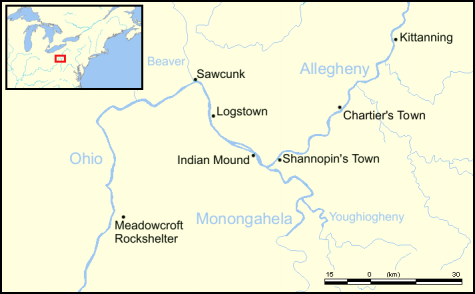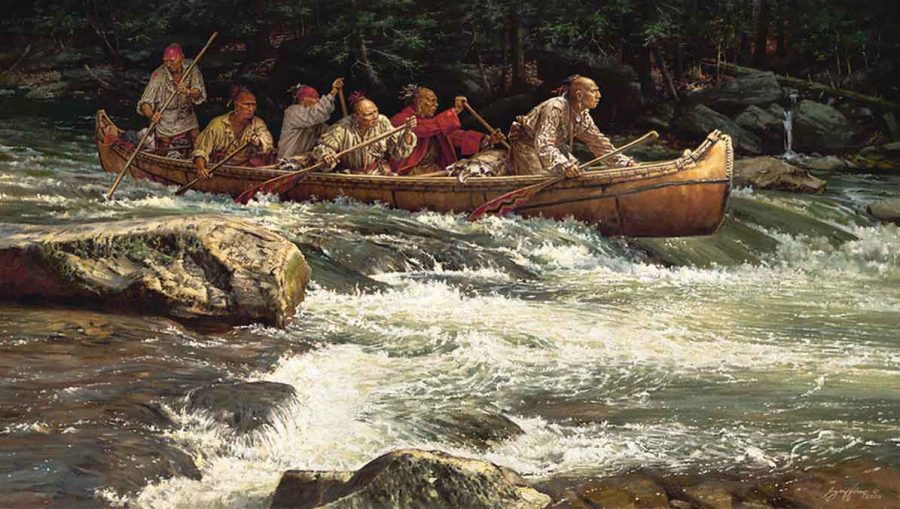Pittsburgh’s Soil
Most Pittsburgh do not know enough about the fascinating history of ancient cultures in what is now western PA.
September 27, 2021
In elementary and middle school, we are told about the founding of Pittsburgh by William Pitt. This is generally where the history of Pittsburgh starts for us, yet what is seldom told is the history of those who lived on this land long before the first European stepped foot here. In the same way that it is important to know how the city one grows up in was founded, it is equally important to understand who lived on the land before the city was founded.
The history of human civilization in what is now western Pennsylvania began over ten thousand years ago. Yet information about these original settlers is now lost to time. The first people we have evidence of were from the Adena culture, who inhabited a region that spanned central Indiana to western Pennsylvania from roughly 1000 BCE to 1 ACE. We mostly know of them from their large mounds they constructed. These mounds were most likely used as burial and ceremonial grounds. Although interestingly enough, the pottery that the Adena made weren’t buried within these mounds with their deceased, unlike other mound-making cultures of the Americas. The most famous of these mounds in the Pittsburgh area is McKees Rocks Mound, located in the Mckees Rocks Borough. Sadly, the mound is about half the size of its original size due to excavation during its discovery.
Around 100 BCE, a new culture began to emerge in the modern Pittsburgh area, the Ohio Hopewell. It is important to share that it is specifically the Ohio Hopewell who lived in the modern area of Pittsburgh, many other cultures called “Hopewell” emerged throughout the east coast of America during this time. However, it is disputed whether the Hopewell were a direct continuation of the Adena or if they were a new group who moved in and merged with the Adena. This dispute mostly originates from the fact they often reused the mounds and tools the Adena made, blurring the two cultures. Make no mistake, the Ohio Hopewell still differed in many areas from the Adena. For instance, the Ohio Hopewell usually cremated their dead rather than putting their dead in mounds. The Ohio Hopewell are also believed to have had a much more complex social structure than the Adena, based around chieftains rather than the more egalitarian structure of Adena groups.
Starting in 500 CE, the Ohio Hopewell culture started to decline for unknown reasons, although war and a period of decreased temperatures during that time are believed to have played a role. After a few hundred years of decline, a new culture emerged in the Pittsburgh area called The Fort Ancient culture around 1000 CE. Exactly how this new culture emerged is unknown, with some suggesting that indigenous people from around modern day Mississippi merged with what remained of the Ohio Hopewell. Others suggest that the Fort Ancient Culture directly descended from the Ohio Hopewell. This new culture may have mysterious origins, but it’s the first culture that lived in Pittsburgh that we have a comparatively detailed record of.
Much like many other native cultures, the cultures within the Fort Ancient people were very diverse. The Fort Ancient cultural group who lived in the Pittsburgh area were the Monongahela. Due to the surplus of information we know about the Monongahela, anthropologists usually divide up the Monongahela into three categories based upon specific pottery designs. The first of the Monongahela, called the early Monongahela, are believed to have first introduced corn farming into the area. Their pottery had a plain design with decoration on the lips and the inside of the rim. Some of their pottery resembled Iroquois pottery, so it is believed they traded with them. Unlike the prior cultures, the Monongahela were more or less sedentary, living in small villages surrounded by wooden walls. These walls often had complex, maze-like entrances, believed to have helped confuse would-be attackers of the village.
The middle and late Monongahela were similar to the early Monongahela, but there were some key differences. The middle Monongahela had undecorated pots with the only decoration being on the lips and the inside of the rim. They differed from the early Monongahela as they had a specific pattern of designs, which were notching, incising, or stamping with a cord-wrapped paddle. The middle Monongahela also had a much more extensive trade network, indicated by pearls and Atlantic sea shells being found in excavation sites of the middle Monongahela.
The late Monongahela are indicated by their radically different pottery designs, decorated with rectangular incising and horizontal punctuated bands. They are believed to have grown large fields of hemp and tobacco, in part due to increased trading allowing for new seeds to be introduced to the area. They were also the first native culture in the modern Pittsburgh area to make contact with European settlers, with the earliest record of contact coming from English explorer Richard Hakluyt in 1599. Around the same time this contact was made, the late Monongahela began to decline. Many factors contributed to this, including two long droughts, diseases from the Settlers and through trading with other native groups, and war with the Iroquois who were moving into the area. This resulted in the remaining Monongahela to gradually be assimilated into the many cultures that composed the Iroquois.

After the gradual disappearance of the Monongahela culture during the 17th and 18th century, the many groups that were a part of the Iroquois moved in. The exact cultures that moved in varied wildly. According to Conrad Wiser, who was visiting an area called Logstown roughly 20 miles from modern Pittsburgh proper, he recorded 789 natives in the settlement. He specified that most were Seneca, Lenape, or Shawnee. Interestingly, both the Lenape and Shawnee weren’t a part of the Iroquois, but had good relations. We also have records of a Seneca village on the east coast of the Allegheny river, where the leader of the Seneca, Aliquippa, lived for a time. There were also two notable combined settlements of Shawnee and Lenape, Kittanning and Sawcunk, in the Pittsburgh area. Not to mention a large Shawnee settlement that may have had up to 400 residents at one point. Sadly, none of these settlements survived to the 19th century.
It is important to remember that this is just a brief overview of the rich history of those who lived on this very soil. Although it may seem like the distant and irrelevant past, every detail of a place’s history often shapes its character.
Pittsburgh is no different. If you were to compare the history of a place to a plant’s growth, you first start in the contents of the soil it grows in.














